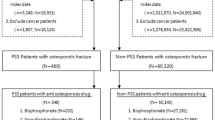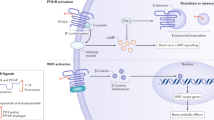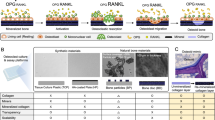Abstract
Bisphosphonates are potent inhibitors of farnesyl pyrophosphate synthase (FPPS) and are highly efficacious in the treatment of bone diseases such as osteoporosis, Paget's disease and tumor-induced osteolysis. In addition, the potential for direct antitumor effects has been postulated on the basis of in vitro and in vivo studies and has recently been demonstrated clinically in early breast cancer patients treated with the potent bisphosphonate zoledronic acid. However, the high affinity of bisphosphonates for bone mineral seems suboptimal for the direct treatment of soft-tissue tumors. Here we report the discovery of the first potent non-bisphosphonate FPPS inhibitors. These new inhibitors bind to a previously unknown allosteric site on FPPS, which was identified by fragment-based approaches using NMR and X-ray crystallography. This allosteric and druggable pocket allows the development of a new generation of FPPS inhibitors that are optimized for direct antitumor effects in soft tissue.
This is a preview of subscription content, access via your institution
Access options
Subscribe to this journal
Receive 12 print issues and online access
$259.00 per year
only $21.58 per issue
Buy this article
- Purchase on SpringerLink
- Instant access to full article PDF
Prices may be subject to local taxes which are calculated during checkout




Similar content being viewed by others
References
Rogers, M.J. New insights into the molecular mechanisms of action of bisphosphonates. Curr. Pharm. Des. 9, 2643–2658 (2003).
Stresing, V., Daubine, F., Benzaid, I., Monkkonen, H. & Clezardin, P. Bisphosphonates in cancer therapy. Cancer Lett. 257, 16–35 (2007).
Gnant, M. et al. Endocrine therapy plus zoledronic acid in premenopausal breast cancer. N. Engl. J. Med. 360, 679–691 (2009).
Poynter, J.N. et al. Statins and the risk of colorectal cancer. N. Engl. J. Med. 352, 2184–2192 (2005).
Fournier, P.G. et al. Lowering bone mineral affinity of bisphosphonates as a therapeutic strategy to optimize skeletal tumor growth inhibition in vivo. Cancer Res. 68, 8945–8953 (2008).
Simoni, D. et al. Design, synthesis, and biological evaluation of novel aminobisphosphonates possessing an in vivo antitumor activity through a gammadelta-T lymphocytes-mediated activation mechanism. J. Med. Chem. 51, 6800–6807 (2008).
Zhang, Y. et al. Lipophilic bisphosphonates as dual farnesyl/geranylgeranyl diphosphate synthase inhibitors: an X-ray and NMR investigation. J. Am. Chem. Soc. 131, 5153–5162 (2009).
Marma, M.S. et al. Synthesis and biological evaluation of alpha-halogenated bisphosphonate and phosphonocarboxylate analogues of risedronate. J. Med. Chem. 50, 5967–5975 (2007).
Hajduk, P.J. & Greer, J. A decade of fragment-based drug design: strategic advances and lessons learned. Nat. Rev. Drug Discov. 6, 211–219 (2007).
Jahnke, W. & Erlanson, D.A. (eds.). Fragment-based Approaches in Drug Discovery (Wiley-VCH, 2006).
Murray, C.W. & Rees, D.C. The rise of fragment-based drug discovery. Nature Chemistry 1, 187–192 (2009).
Rondeau, J.M. et al. Structural basis for the exceptional in vivo efficacy of bisphosphonate drugs. ChemMedChem 1, 267–273 (2006).
Kavanagh, K.L. et al. The molecular mechanism of nitrogen-containing bisphosphonates as antiosteoporosis drugs. Proc. Natl. Acad. Sci. USA 103, 7829–7834 (2006).
Jahnke, W. et al. NMR reporter screening for the detection of high-affinity ligands. Angew. Chem. Int. Edn Engl. 41, 3420–3423 (2002).
Roddy, T.P. et al. Mass spectrometric techniques for label-free high-throughput screening in drug discovery. Anal. Chem. 79, 8207–8213 (2007).
Glickman, J.F. & Schmid, A. Farnesyl pyrophosphate synthase: real-time kinetics and inhibition by nitrogen-containing bisphosphonates in a scintillation assay. Assay Drug Dev. Technol. 5, 205–214 (2007).
Simonen, M. et al. High-content assay to study protein prenylation. J. Biomol. Screen. 13, 456–467 (2008).
Dunford, J.E. et al. Structure-activity relationships among the nitrogen containing bisphosphonates in clinical use and other analogues: time-dependent inhibition of human farnesyl pyrophosphate synthase. J. Med. Chem. 51, 2187–2195 (2008).
Abad-Zapatero, C. & Metz, J.T. Ligand efficiency indices as guideposts for drug discovery. Drug Discov. Today 10, 464–469 (2005).
Wohnsland, F. & Faller, B. High-throughput permeability pH profile and high-throughput alkane/water log P with artificial membranes. J. Med. Chem. 44, 923–930 (2001).
Faller, B. et al. High-throughput in vitro profiling assays: lessons learnt from experiences at Novartis. Expert Opin. Drug Metab. Toxicol. 2, 823–833 (2006).
Jahnke, W. & Henry, C. An in vitro assay to measure targeted drug delivery to bone mineral. ChemMedChem 5, 770–776 (2010).
Gozzetti, A. et al. The effects of zoledronic acid on serum lipids in multiple myeloma patients. Calcif. Tissue Int. 82, 258–262 (2008).
Montagnani, A. et al. Changes in serum HDL and LDL cholesterol in patients with Paget's bone disease treated with pamidronate. Bone 32, 15–19 (2003).
Davignon, J. & Leiter, L.A. Ongoing clinical trials of the pleiotropic effects of statins. Vasc. Health Risk Manag. 1, 29–40 (2005).
Rebollo, A., Pou, J. & Alegret, M. Cholesterol lowering and beyond: role of statins in Alzheimer's disease. Aging Health 4, 171–180 (2008).
Docampo, R. & Moreno, S.N. Bisphosphonates as chemotherapeutic agents against trypanosomatid and apicomplexan parasites. Curr. Drug Targets Infect. Disord. 1, 51–61 (2001).
Varela, I. et al. Combined treatment with statins and aminobisphosphonates extends longevity in a mouse model of human premature aging. Nat. Med. 14, 767–772 (2008).
Wang, X., Hinson, E.R. & Cresswell, P. The interferon-inducible protein viperin inhibits influenza virus release by perturbing lipid rafts. Cell Host Microbe 2, 96–105 (2007).
Stockman, B.J. & Dalvit, C. NMR screening techniques in drug discovery and drug design. Progr. NMR Spectrosc. 41, 187–231 (2002).
Otwinowski, Z. & Minor, W. Processing of x-ray diffraction data collected in oscillation mode. Methods Enzymol. 276, 307–326 (1997).
Kabsch, W. Automatic processing of rotation diffraction data from crystals of initially unknown symmetry and cell constants. J. Appl. Cryst. 26, 795–800 (1993).
Kroemer, M., Dreyer, M.K. & Wendt, K.U. APRV—a program for automated data processing, refinement and visualization. Acta Crystallogr. D Biol. Crystallogr. 60, 1679–1682 (2004).
Brünger, A.T. et al. Crystallography & NMR system: a new software suite for macromolecular structure determination. Acta Crystallogr. D Biol. Crystallogr. D54, 905–921 (1998).
Jones, T.A., Zou, J.Y., Cowan, S.W. & Kjeldgaard, M. Improved methods for building protein models in electron density maps and the location of errors in these models. Acta Crystallogr. A A47, 110–119 (1991).
Acknowledgements
We thank G. Hofmann for help with the plasma membrane translocation assay, A. Schmid for help with the scintillation proximity assay, R. Denay for recording the 13C NMR spectra, W. Breitenstein for help in preparing the manuscript and B. Faller for useful discussions. X-ray data collections of the FPPS complexes with 1 to 4, 8 and 10 were performed at the Swiss Light Source, Paul Scherrer Institut, Villigen, Switzerland. We are grateful to the machine and beamline groups whose outstanding efforts have made these experiments possible.
Author information
Authors and Affiliations
Contributions
W.J. initiated the project, led the project team and performed NMR studies together with C.H. J.-M.R. and S.L. performed crystallographic studies. S.C. performed molecular modeling studies. A.M. and X.P. synthesized chemical compounds. M. Geiser, A.S. and R.H. cloned, expressed and purified protein. M. Götte performed the cellular assay, F.B. performed ITC experiments, J.F.G., T.P.R. and S.J.S. performed the biochemical assay. W.J., J.-M.R. and J.R.G. wrote the paper with input from all coauthors.
Corresponding author
Ethics declarations
Competing interests
All authors are past or present full-time employees of Novartis AG and hold stock in the company.
Supplementary information
Supplementary Text and Figures
Supplementary Figures 1–7, Supplementary Tables 1 & 2 and Supplementary Methods (PDF 479 kb)
Rights and permissions
About this article
Cite this article
Jahnke, W., Rondeau, JM., Cotesta, S. et al. Allosteric non-bisphosphonate FPPS inhibitors identified by fragment-based discovery. Nat Chem Biol 6, 660–666 (2010). https://doi.org/10.1038/nchembio.421
Received:
Accepted:
Published:
Issue date:
DOI: https://doi.org/10.1038/nchembio.421
This article is cited by
-
Post-translational modification of KRAS: potential targets for cancer therapy
Acta Pharmacologica Sinica (2021)
-
Human farnesyl pyrophosphate synthase is allosterically inhibited by its own product
Nature Communications (2017)
-
Biophysics in drug discovery: impact, challenges and opportunities
Nature Reviews Drug Discovery (2016)
-
Small-molecule modulation of Ras signaling
Nature Chemical Biology (2014)
-
Ternary complex structures of human farnesyl pyrophosphate synthase bound with a novel inhibitor and secondary ligands provide insights into the molecular details of the enzyme’s active site closure
BMC Structural Biology (2012)



